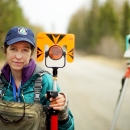Our Services
The National Fish Passage Program improves community infrastructure resilience, rebuilds fish populations, improves recreational and commercial fisheries, and restores the beauty of free-flowing waters. We provide financial and technical assistance to support projects that improve fish passage fish passage
Fish passage is the ability of fish or other aquatic species to move freely throughout their life to find food, reproduce, and complete their natural migration cycles. Millions of barriers to fish passage across the country are fragmenting habitat and leading to species declines. The U.S. Fish and Wildlife Service's National Fish Passage Program is working to reconnect watersheds to benefit both wildlife and people.
Learn more about fish passage .
Project proposals may be initiated by any individual, organization, government, or agency, in cooperation with their local Fish and Wildlife Conservation Office. Contact a Fish Passage Coordinator in your area or contact your local Fish and Wildlife Conservation Office, to discuss the project and learn more about the technical assistance that is available.
Technical and Planning Assistance
U.S. Fish and Wildlife Service biologists and engineers are available to provide assistance in the planning, design, implementation, and monitoring of select fish passage projects.
Fish Passage Engineering
Experienced civil and hydraulic engineers working in the fields of fish passage and protection can provide technical assistance in the planning, design, and evaluation of projects to improve conservation outcomes.
Financial Assistance
The National Fish Passage Program provides funding to support fish passage projects You must work with a Fish and Wildlife Conservation Office Biologist to be considered for funding. To begin this process, please contact your Regional Fish Passage Coordinator or your local Fish and Wildlife Conservation Office.
Get Started
Fish passage project proposals can be initiated by any individual, organization, government, or agency. However proposals must be submitted and completed in cooperation with a Fish and Wildlife Conservation Office. (Please note that fish passage projects being used for Federal or State compensatory mitigation or required by existing Federal or State regulatory programs are not eligible for funding through the National Fish Passage Program. )


